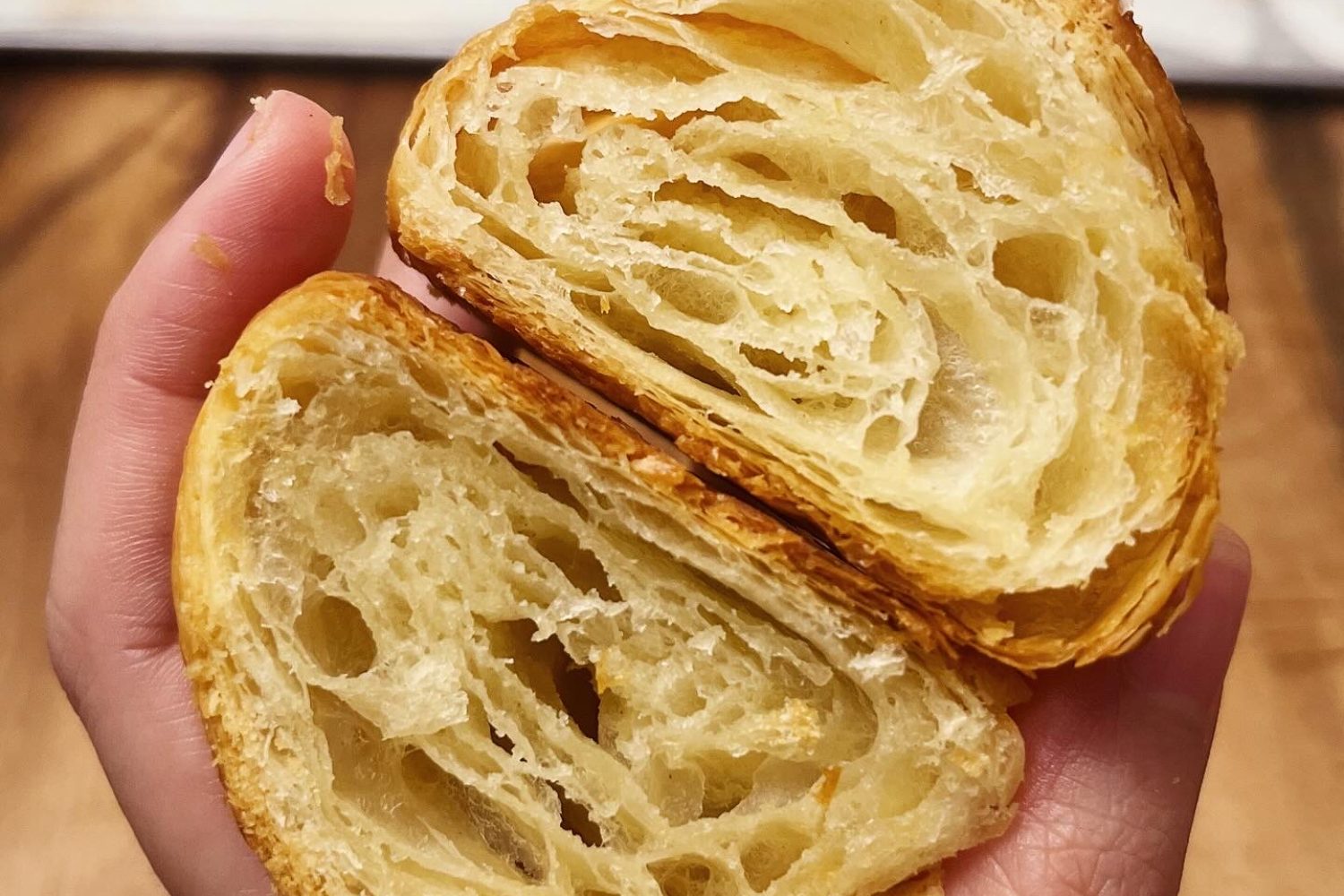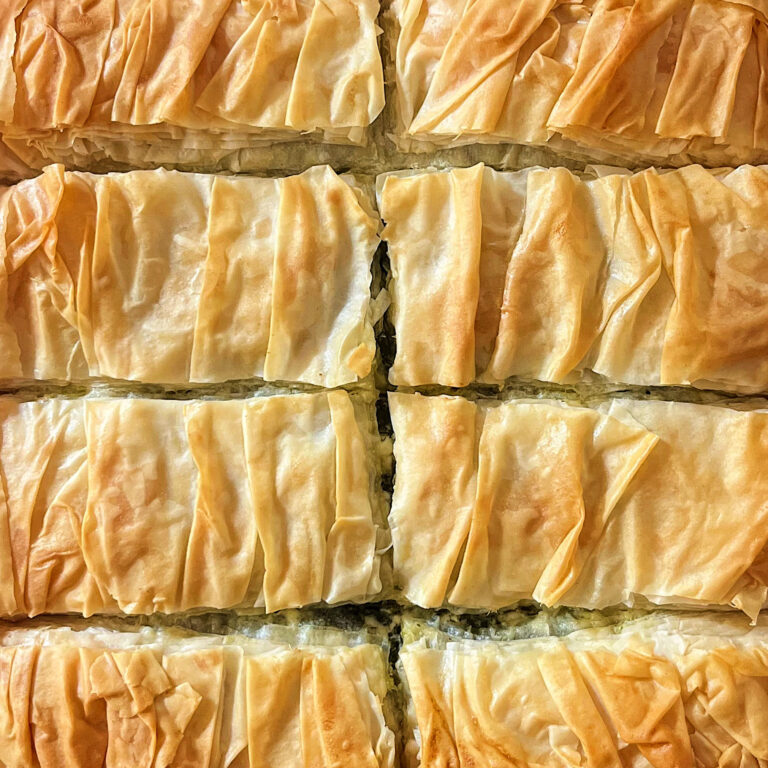Doable, but not for the faint of heart!
Croissants are some of the most challenging pastries to make at home. Whichever recipe you end up trying, it all boils down to technique and intuition. There are just SO many variables that can affect your results drastically.
The truth is if you’re making croissants at home for the first time, you have to see it as lesson #1. It’s nearly impossible to get them right in one attempt, and that’s okay. The mistakes are crucial in building foundational skills to help you adapt to the variables you may encounter in each batch.
Change of weather? Adjust. Different butter? Adjust. Fridge fuller than usual? Adjust. Test minor changes with every batch until you get it right. It’s a journey, and a highly fulfilling one at that.
Here’s the method that worked for me at home, here in the Philippines. I don’t have a dough sheeter so I rolled everything by hand. I do have an airconditioner in my work area, though—so that helped a lot.
Before attempting any croissant recipe (whether this or someone else’s), I suggest watching croissant video tutorials. Claire Saffitz, Matt Adlard, and Benny’s Baked share great examples. I promise to follow up on this with my own video tutorial soon!
Have you tried making croissants before? Let me know in the comments!
Homemade Croissants
Yield: 6 croissants
Work Time: 2 days, mostly inactive
Bake Time: 20-25 minutes
INGREDIENTS
Dough / Détrempe
- 250g bread flour
- 30g granulated sugar
- 6g instant dry yeast
- 6g fine salt
- 70g water
- 70g whole milk
- 25g unsalted butter, softened
- Extra flour for kneading, see tips.
Butter Block / Beurrage
- 130g European butter, ideally extra dry laminating butter with 84% fat
Egg Wash
- 1 large egg
- 1 tbsp. water
EQUIPMENT
- Stand mixer
- Infrared thermometer
- Large rolling pin
- Ruler or measuring tape
- Small paring knife
- Pastry brush
- Silicone mat, optional but preferred
- Pastry/pizza wheel cutter, optional but preferred
- Probe thermometer, optional but preferred
- Enough space in freezer and chiller to fit a tray
METHOD
DAY 1
- MIX. In a stand mixer fitted with the dough hook, mix bread flour, instant dry yeast, and sugar. Stream in milk and water. Knead on low until it forms a rough dough. Add butter, knead on low-medium until absorbed, then add salt.
- KNEAD. Knead on medium speed until the dough is smooth, stretchy, and forms a large windowpane, about 4x4cm. See tips.
- PROOF. Shape dough into a ball. Take the internal temperature with a probe thermometer. For a 28°C dough in 26-28°C room temperature, cover with cling wrap and proof for 20 minutes or until 1.5x in size. Adjust time depending on your dough and room temperature (colder doughs and rooms will take a bit longer to proof).
- OVERNIGHT REST. Flatten the dough into a large rectangle on a silicone mat or parchment-lined baking tray. Cover with cling wrap and freeze for 15 minutes or until 0°C, then transfer to the chiller to rest (covered loosely) at 4°C for 12-18 hours.
DAY 2
- BEURRAGE. Fold a large parchment sheet to form a 20x15cm rectangle packet. Cut European butter into strips and place inside, making sure the butter is fully covered with parchment on all sides. Invert the packet so the open ends of the parchment are underneath, and the top is smooth. Pound with a rolling pin to plasticize and form a butter block with even thickness all throughout. Chill the butter block until firm. (Do not freeze.)
- ROLL. On a lightly floured work surface, roll chilled dough to a 22x30cm rectangle. If the dough resists, return to the chiller before proceeding. Once shaped, return to the tray (lined with the silicone mat or parchment). Cover with cling wrap and freeze until firm, about 8-10°C.
PAUSE & READ: The texture of the dough and the butter block are crucial.
- The dough must be colder and firmer than the butter. In my case, around 8-10°C.
- The butter must be cold, firm, and slightly bendable. In my case, around 11-14°C.
- Temperatures vary, especially with different butter brands. Prioritize the texture! When your dough and butter meet these conditions, you’re ready to proceed.
- LOCK-IN: Use the silicone mat to lift the dough onto the work surface—no need to remove from the mat. Roll to reshape the 22x30cm rectangle, oriented horizontally. Immediately place and unwrap your firm-but-flexible 20x15cm butter block vertically on the center. Fold the left and right sides of the dough towards the midline of the butter block, covering it completely. Pinch all seams (middle, top, and bottom) to fully enclose. With a paring knife, slit the left and right edges to release tension. You now have a croissant dough block about 20x15cm in size, oriented vertically.
- ROLL. Lift the entire croissant dough and lightly dust flour underneath. With your rolling pin perpendicular to the slits, roll and lengthen the dough to about 50cm, aiming for 3-4mm thickness. Trim about 1 cm each on both ends to remove excess dough not containing any butter.
- 1ST TURN: DOUBLE FOLD. With the dough oriented horizontally, envision a vertical line that marks ¾ of the long rectangle. Fold the left edge towards this line, and fold the right edge towards the same line—meeting both edges. Now, fold the entire dough in half (left over right). With a paring knife, slit the left and right edges to release tension.
- REST. Lift the silicone mat to transfer the dough onto the tray. Flatten slightly with a rolling pin. Cover with cling wrap and chill for at least 1 hour.
- ROLL. Use the silicone mat to lift the dough onto the work surface—no need to remove from the mat. Lift the dough briefly and lightly dust flour underneath. With the rolling pin perpendicular to the slits, roll and lengthen the dough again to 50cm long, about 3-4mm thick. Trim about 1 cm each on both ends.
- 2ND TURN: SINGLE FOLD. With the dough oriented horizontally, envision two vertical lines that divide the rectangle into 3 equal parts: the left, the center, and the right. Fold the left third over the center, then the right third on top of that. With a paring knife, slit the left and right edges.
- REST. Lift the silicone mat to transfer the dough onto the tray. Flatten slightly with a rolling pin. Cover with cling wrap and chill for at least 1 hour.
- FINAL ROLL. Lift the dough and place directly on a lightly floured work surface. Widen and roll to a rectangle 3mm thick, about 25x30cm in size oriented vertically. (Tip: The length and width may vary, but do aim for 3mm thickness). If the dough resists, return to the chiller to rest for 30 minutes to 1 hour. See tips.
- CUT. Trim the edges of the dough to keep it neat. Divide the dough into 3 and cut with a pastry/pizza wheel cutter or a large knife. You should end up with 3 equal rectangles, roughly 8x30cm each. Cut diagonally to form 6 right triangles. Place one triangle on the work surface; you may cover and chill the other triangles at this time.
- SHAPE. Trim the bottom edge of each right triangle to form an isosceles triangle. Roll from the base upwards and flatten the tip before sealing onto the bottom of the croissant. Place seam-side down on a parchment-lined baking tray and proceed with shaping the remaining triangles.
- EGG WASH. Beat egg and mix with water. Lightly brush over the shaped croissants before proofing.
- PROOF. Cover loosely with cling wrap and proof at 26-28°C for 2-6 hours. (At 27°C, I took about 4.5 hours). See tips.
- PREHEAT. When the croissants are almost fully proofed, preheat the oven to 220°C.
- EGG WASH. When the oven is ready, carefully uncover the croissants and lightly brush a second layer of egg wash.
- BAKE. Bake at 220°C for 20-25 minutes or until golden brown. Note: Baking temperature and baking time varies per person. If after 10 minutes your croissants are browning too quickly, you may lower the heat to 200°C.
- COOL. Transfer to a wire rack to cool before slicing. Enjoy!
TIPS
Butter can make or break your dough.
For best results, invest in croissant laminating butter with at least 84% fat, such as Elle & Vire Extra Dry Butter or Anchor Lamination Butter Sheets. The higher fat content and lower water content prevents melting and breaking during lamination, giving you the best chance at producing flaky layers. Your second best option would be European butter brands with at least 82% fat. When pounding your butter block, pound it heavily all throughout to plasticize it or make it flexible before chilling and locking in.
How do I know when to stop kneading?
The total kneading time is highly variable. Factors such as the strength and size of your mixer, the brand of your bread flour, and more can affect this step. It’s important to note that the main objective of kneading is to build structure through gluten development. Follow these visual cues, and you’re in for a successful batch:
- The dough is much smoother.
- The dough forms a good windowpane.
Note: Different croissant recipes call for different stages in gluten development. Because this recipe will only undergo two turns (1 double fold, 1 single fold), forming a good windowpane is essential in making sure the dough doesn’t crack during shaping or proofing.
Lamination tips?
First of all—always work with firm and cold (but never frozen!) dough. The butter sheet inside the dough must remain intact for it to form flaky layers during baking. If the butter melts into the dough, you will just end up with croissant-shaped brioche. If your dough begins to feel limp, cover and let it rest in the chiller for at least 30 minutes before proceeding.
Second—the length is not as important as its thickness. Hand-laminated dough is more prone to retraction compared to mechanically laminated dough, so aiming for 3-4mm thickness is best.
Third—keep extra flour to a minimum. During lamination, use a dry pastry brush to remove the excess flour on the dough and prevent any large holes from forming in your croissants.
Temperature control?
Each home will have a different room temperature, and here in the Philippines it can get extremely hot and humid—especially during the summer. If you don’t have an air-conditioned work space, I suggest to at least work in a cool area away from direct sunlight, no higher than 28°C. For good measure, always keep an infrared thermometer on hand!
How do I know if my croissants are fully proofed?
Proofing time is another highly variable aspect of croissant-making. Some take 3 hours, some can take 6 hours. Aside from your room temperature, it can also be affected by your yeast quality (old yeast takes longer!). As a guide, follow and aim for these visual cues:
- The croissants are large and puffy (about 2-3x in size!).
- The croissants are jiggly when you gently shake the tray.
- The layers are visibly separating when viewed from the side.

My sample schedule!
Here’s my rough schedule for these 2-day croissants. I don’t follow this schedule religiously—again, it all depends on the adjustments I have to make throughout the process.
Day 1
- 3:00 pm – Make dough until windowpane.
- 3:15 pm – Cover and rest 10-20 mins. until 1.5x size.
- 3:30 pm – Flatten and freeze for 15 mins.
- 3:45 pm – Cover and rest in chiller for 12-18 hours.
Day 2
- 8:00 am – Weigh and shape butter block. Chill until ready.
- 9:00 am – Roll dough to length. Freeze until ready.
- 9:10 am – Lock-in butter. Dough must be colder/firmer than the butter.
- 9:15 am – Roll to length, about 4mm thickness. Double fold.
- 9:30 am – Wrap and chill for 1 hour.
- 10:30 am – Roll to length, about 4mm thickness. Single fold.
- 10:45 am – Wrap and chill for 1 hour.
- 11:45 am – Roll to size, 3mm thickness.
- 12:00 pm – Trim, cut & shape 6 croissants. Egg wash.
- 12:15 pm – Cover and proof for 2-6 hours* at 27-28°C.
- 4:15 pm – Preheat the oven to 220°C when proofing is almost done.
- 4:30 pm – After proofing, gently brush again with egg wash.
- 4:35 pm – Bake at 220°C for 20-25 minutes or until golden brown.
*AGAIN, PROOFING TIME VARIES. Go by visual cues!
Lastly, practice.
Gathering information can only prepare you so much—but it all comes down to practical application. My biggest tip is to try it first, document your steps (at least in photos), and adjust from there. It’s challenging, but the best part is that even the mistakes are delicious!
I genuinely hope this recipe helps you gain confidence to attempt your first homemade croissants. It can be quite intimidating, but trust me: croissant failure is both inevitable and necessary in croissant success. You got this!
Thank you for checking out my recipes! Let me know when you try them out. If you have any questions, comment below or reach me on TikTok / Instagram!
How useful was this post?
Users rated this 0 / 5. Rate count: 0
Be the first to rate this.






2 thoughts on “Homemade Croissants”
Hello po, Chef Anna! Planning to attempt your croissant recipe po. May I ask po what brand of bread flour did you use / recommend? Thank you 😊
Yay! Let me know how it goes. 🙂 I don’t recall the exact bread flour I used for this, but I usually use San Miguel Bread flour or the bread flour at All About Baking. Good luck!